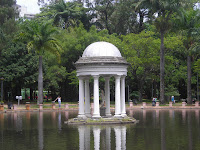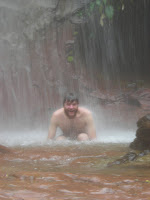





A new land, a new language (a weird sounding one at that!) and a wallet busting new currency were a lot to take in at first. Our first impressions were not good as we sweated our way into the vast Brazilian lowlands. We quickly rushed through Corumba and Campo Grande making the most of the overnight buses to save on accomodation costs. Thankfully, the presence of tarmac and air-conditioning made our first 24 hour bus ride to Brasilia a breeze.
We arrived in the capital of Brazil, a 1960's vision of the future, president Kubitschek's planned city master-minded by the modernist Oscar Niemeyer. It was a queer place to be a tourist. The city's raison d'étre is the administration of government and there was little in the way of traditional tourism. The fastest growing city in Brasil is a bustling concrete metropolis of 2.5 million people and is oddly shaped like a bird. Due to the vast distances between quadras walking was not pratical and we suspect that Oscar Niemeyer expected us to be zooming about in Jetson like hover-cars. However, despite the difficulties Brasilia was well worth a visit due to some of the most extraordinary modernist architecture in the world. In particular, we were blown into outerspace by the Palacio Itamaraty, a stunning open white interior used to entertain foreign dignitaries and sign important international treaties. It was a sight to behold with the lush jungle garden, floating spiral staircase and magic-eye sculptures. With all the walking and sightseeing we built up a good appetite and indulged in a wonderful platter of sushi, our first taste of seafood in months... yum, yum! With Carnaval fast approaching we decided to make a 26 hour dash for Salvador....
We took a bit of a risk going to Salvador as we had heard that it was Brazilians' favourite place to party and that finding accomodation would be a challenge. However, we felt it was preferable to take a chance on Salvador and avoid the expensive, tourist filled, commercial Carnaval that we suspect Rio has become (every single Gringo we met was heading to Rio!). Armed with a tent we decided to skip the hotel search and head straight to the beach side campsite 30 minutes outside of Salvador. This turned out to be a stroke of genius as we found a quaint little campsite surrounded by palm trees, literally metres from a perfect white sand beach and a warm turquoise sea. The Coco Verdes were an additional bonus, ice cold coconut juice straight from the nut.
Salvador was the original capital of Brazil and was where the Portuguese first landed (some of which were eaten by the indigenous peoples!). It was also the main slave trading post in Brazil and this has left a legacy of beautiful colonial buildings and a dominant Afro-Brazilian culture. Carnaval in Salvador is a massive free for all street party. Craziness and mayhem is the rule rather than the exception and we threw ourselves in with gay abandon. One float in particular called 'Black Style' was memorable as we were the only two westerners in a sea of Afro-Brazilians. The locals were welcoming, warm and generous and reinforced our belief that racial prejudices are built on a foundation of ignorance and misunderstanding. Sadly, the military police were less enlightened and we witnessed several instances of police brutality for very minor infractions. However, this did not stop most people from partying into the wee hours!
After three days of enjoying the electric Carnaval atmosphere and soaking up the rays on the beach it was time to head South. Next stop (24 hours away) was Belo Horizonte, Brazil's third largest city. This city is little known outside of Brazil as there are no beaches, big Jesuses or famous architecture but we found it to be one of the most friendly and liveable cities we have visited. Over the course of three days we slurped on delicious Acai berry smoothies, ate the most delicious tropical fruit, spoke to locals in the lively bars and best of all went to a Brazilian football match (the Belo Horizonte derby between Cruzeiro and Atletico no less!). Never before have we experienced an atmosphere like it. The whole crowd was jumping up and down from start to finish and the noise was incredible. We were in the Atletico end who ended up losing 3-1 after letting in sloppy 2 goals in the dying minutes of the game. It was a bit like watching Hibs play(except they could pass and control the ball better!). After the game we were treated to more police brutality as the horse mounted, baton wielding police charged at the rioting fans. The helicopters circling overhead also added to the excitement! Indeed we have seen more police brutality in the last ten days than we have seen in the rest of our lives. After a few games of pool and a giant pizza we crashed out after an exhilerating and adrenaline filled day. The Sunday after we went to the largest outdoor market in South America with over 3,000 stalls. Lydia enjoyed the market while I couldn't wait to escape and prepare for the next leg of our journey...












































